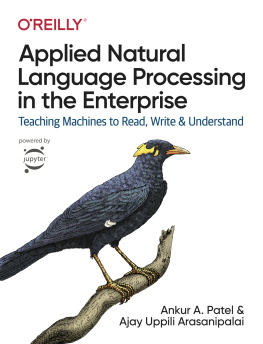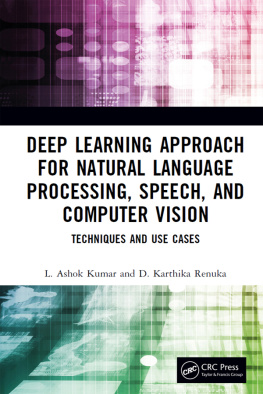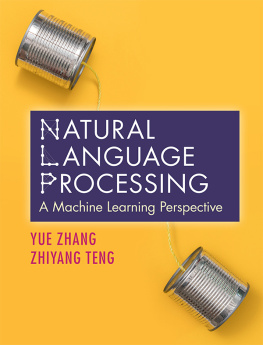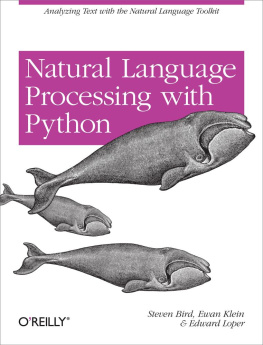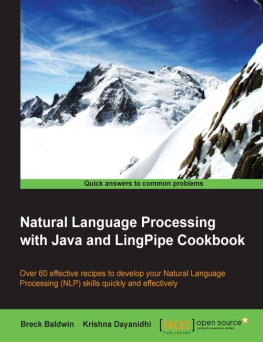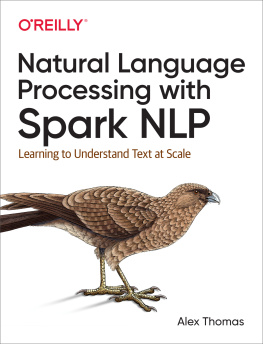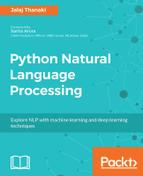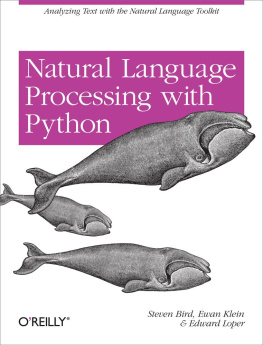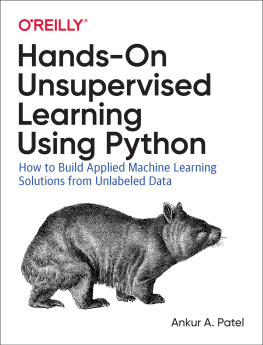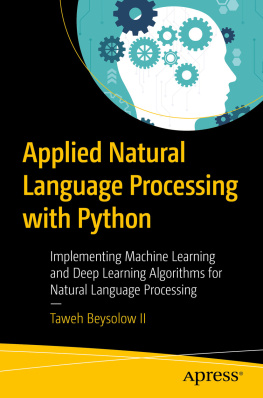Ankur A. Patel - Applied Natural Language Processing in the Enterprise
Here you can read online Ankur A. Patel - Applied Natural Language Processing in the Enterprise full text of the book (entire story) in english for free. Download pdf and epub, get meaning, cover and reviews about this ebook. year: 2021, publisher: OReilly Media, Inc., genre: Home and family. Description of the work, (preface) as well as reviews are available. Best literature library LitArk.com created for fans of good reading and offers a wide selection of genres:
Romance novel
Science fiction
Adventure
Detective
Science
History
Home and family
Prose
Art
Politics
Computer
Non-fiction
Religion
Business
Children
Humor
Choose a favorite category and find really read worthwhile books. Enjoy immersion in the world of imagination, feel the emotions of the characters or learn something new for yourself, make an fascinating discovery.
- Book:Applied Natural Language Processing in the Enterprise
- Author:
- Publisher:OReilly Media, Inc.
- Genre:
- Year:2021
- Rating:4 / 5
- Favourites:Add to favourites
- Your mark:
- 80
- 1
- 2
- 3
- 4
- 5
Applied Natural Language Processing in the Enterprise: summary, description and annotation
We offer to read an annotation, description, summary or preface (depends on what the author of the book "Applied Natural Language Processing in the Enterprise" wrote himself). If you haven't found the necessary information about the book — write in the comments, we will try to find it.
Applied Natural Language Processing in the Enterprise — read online for free the complete book (whole text) full work
Below is the text of the book, divided by pages. System saving the place of the last page read, allows you to conveniently read the book "Applied Natural Language Processing in the Enterprise" online for free, without having to search again every time where you left off. Put a bookmark, and you can go to the page where you finished reading at any time.
Font size:
Interval:
Bookmark:

by Ankur A. Patel and Ajay Uppili Arasanipalai
Copyright 2021 Human AI Collaboration, Inc. and Taukren, LLC. All rights reserved.
Printed in the United States of America.
Published by OReilly Media, Inc. , 1005 Gravenstein Highway North, Sebastopol, CA 95472.
OReilly books may be purchased for educational, business, or sales promotional use. Online editions are also available for most titles (http://oreilly.com). For more information, contact our corporate/institutional sales department: 800-998-9938 or corporate@oreilly.com .
- Acquisitions Editor: Jonathan Hassell
- Development Editor: Melissa Potter
- Production Editor: Deborah Baker
- Copyeditor: Kim Cofer
- Proofreader: Piper Editorial Consulting, LLC
- Indexer: nSight, Inc.
- Interior Designer: David Futato
- Cover Designer: Karen Montgomery
- Illustrator: Kate Dullea
- June 2021: First Edition
- 2021-05-11: First Release
See http://oreilly.com/catalog/errata.csp?isbn=9781492062578 for release details.
The OReilly logo is a registered trademark of OReilly Media, Inc. Applied Natural Language Processing in the Enterprise, the cover image, and related trade dress are trademarks of OReilly Media, Inc.
The views expressed in this work are those of the authors, and do not represent the publishers views. While the publisher and the authors have used good faith efforts to ensure that the information and instructions contained in this work are accurate, the publisher and the authors disclaim all responsibility for errors or omissions, including without limitation responsibility for damages resulting from the use of or reliance on this work. Use of the information and instructions contained in this work is at your own risk. If any code samples or other technology this work contains or describes is subject to open source licenses or the intellectual property rights of others, it is your responsibility to ensure that your use thereof complies with such licenses and/or rights.
978-1-492-06257-8
[LSI]
Many of you work with numerical data on a daily basis, either in a spreadsheet program like Microsoft Excel or in a programming environment such as Jupyter Notebook. When you work with numbers, you leave the number-crunching up to the computer. There is almost no reason for you not to.
Computers are fast and precise with number-crunching, whereas the human brain gets bogged down easily. If asked to calculate 24 36 48, humans would not hesitate for a second to pull out a calculator or a computer and let the machines do the heavy lifting.
But, when it comes to analyzing textual data, the mighty number-crunching machines have not been so good, historically speaking. Humans use computers to crunch numbers but rely on the human brain to analyze documents with text. To date, this inability to work with text has limited the scope of work machines could handle.
This is about to change. In many ways, this change is already well underway. Machines are now able to process text and audio in ways that most humans would have considered magical just two decades ago.
Consider just how much you rely on computers to analyze and make sense of textual data in the everyday world around you. Here are several examples:
Google SearchSearch the entire web and surface relevant search results.
Google GmailAuto-complete sentences as you write emails.
Google TranslateConvert text and audio from one language to another.
Amazon Alexa, Apple Siri, Google Assistant, Microsoft CortanaGive voice commands and control your home devices.
Customer Service ChatbotsAsk account-related questions and get (mostly reasonable) answers.
These technologies have become ingrained in our daily lives so gradually and seamlessly that we almost forget just how much we use them day to day. The story of machines being able to work with textual data is just getting started. Over the past few years, there have been pretty dramatic advances in this field, and, over time, we will see computers handle more and more of the work that only humans were capable of doing in the past.
Natural language processing (NLP) is one of the hottest topics in AI today. Having lagged behind other deep learning fields such as computer vision for years, NLP only recently gained mainstream popularity. Even though Google, Facebook, and OpenAI have open sourced large pretrained language models to make NLP easier, many organizations today still struggle with developing and productionizing NLP applications. This hands-on guide helps you learn the field quickly.
This book is not for complete beginners. We are going to assume that you already know a bit about machine learning and that you have used Python and libraries such as NumPy, pandas, and matplotlib before.
For more on Python, visit the official Python website, and for more on Jupyter Notebook, visit the official Jupyter site. For a refresher on college-level calculus, linear algebra, probability, and statistics, read Part I of the textbook Deep Learning (MIT Press) by Ian Goodfellow, Yoshua Bengio, and Aaron Courville. For a refresher on machine learning, read The Elements of Statistical Learning (Springer) by Jerome H. Friedman, Robert Tibshirani, and Trevor Hastie.
If you have basic-to-intermediate understanding of machine learning and programming experience with Python, youll learn how to build and deploy real-world NLP applications in your organization.
We will walk you through the process without bogging you down in theory.
After reading this book and practicing on your own, you should be able to do the following:
Understand how state-of-the-art NLP models work.
Learn the tools of the trade, including the most popular frameworks today.
Perform NLP tasks such as text classification, semantic search, and reading comprehension.
Solve problems using new transformer-based models and techniques such as transfer learning.
Develop NLP models with performance comparable or superior to out-of-the-box systems.
Deploy models to production and monitor and maintain their performance
Implement a suite of NLP algorithms using Python and PyTorch.
Our books goal is to outline the concepts and tools required for you to develop the intuition necessary to apply this technology to everyday problems that you work on. In other words, this is an applied book, one that will allow you to build real-world applications. This book will not have every bit of theory that is relevant to NLP, and you will have to supplement your knowledge in the space using other resources over time, but we will get you started and well underway in this field.
The book will use a hands-on approach, introducing some theory but focusing mostly on applying natural language techniques to solving real-world problems. The datasets and code are available online as Jupyter Notebooks on our GitHub repo.
This book is organized into three parts.
)These chapters focus on a high-level overview of NLP, including the history of NLP, the most popular applications in the field, and how to use pretrained models to perform transfer learning and solve real-world problems quickly.
Font size:
Interval:
Bookmark:
Similar books «Applied Natural Language Processing in the Enterprise»
Look at similar books to Applied Natural Language Processing in the Enterprise. We have selected literature similar in name and meaning in the hope of providing readers with more options to find new, interesting, not yet read works.
Discussion, reviews of the book Applied Natural Language Processing in the Enterprise and just readers' own opinions. Leave your comments, write what you think about the work, its meaning or the main characters. Specify what exactly you liked and what you didn't like, and why you think so.

